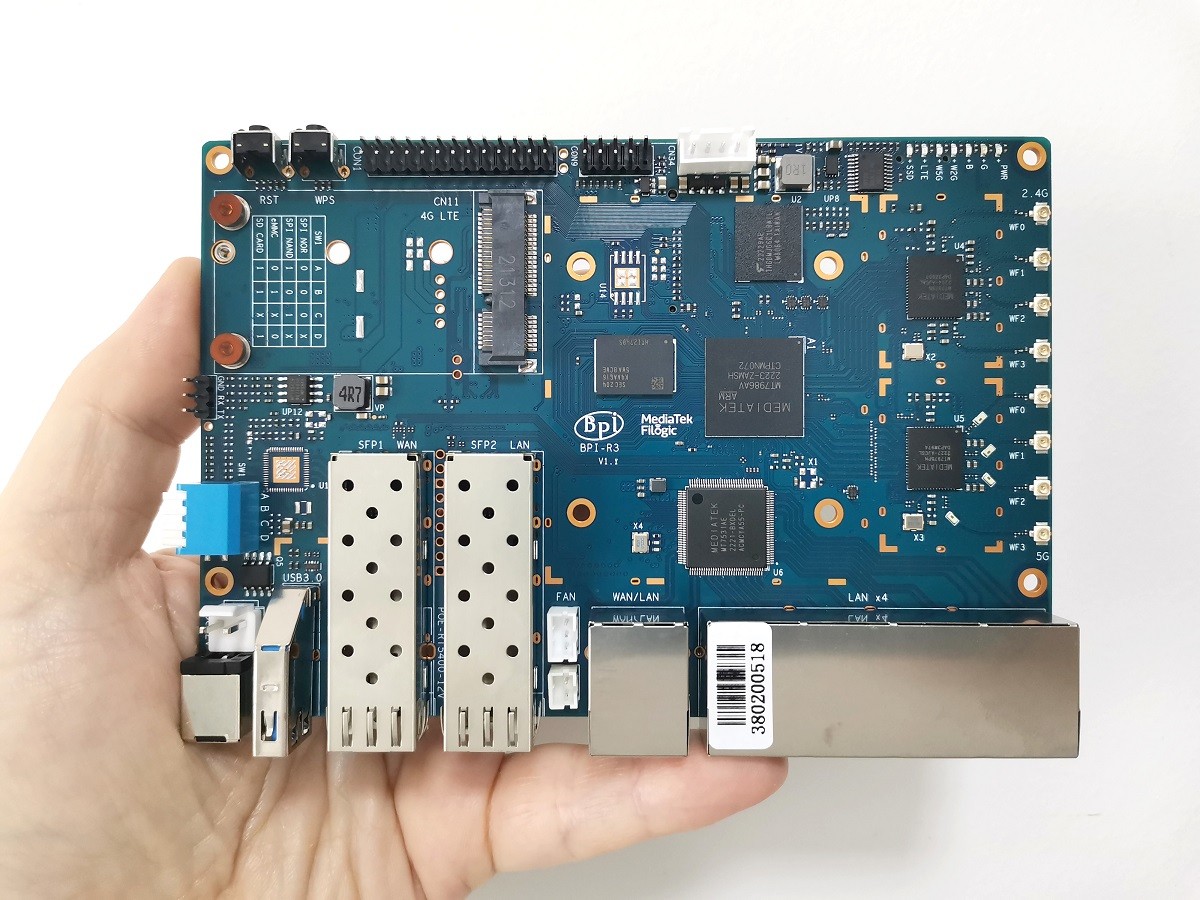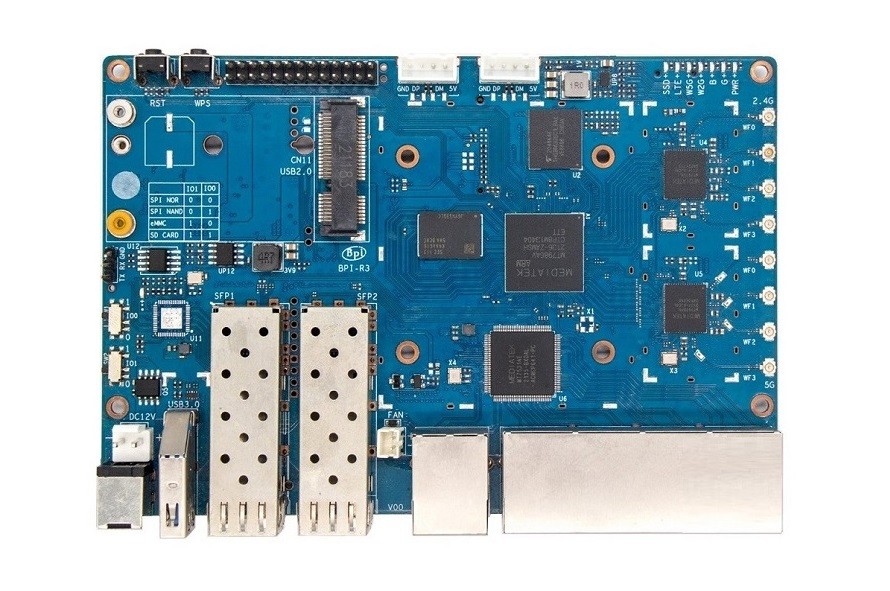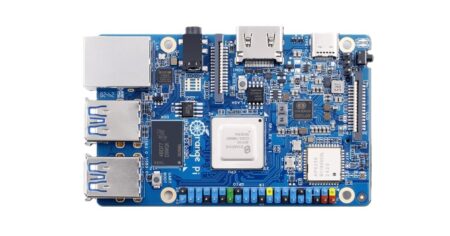Final Thoughts
- WiFi performance: is slightly above average, so don’t expect to be equivalent to more expensive premium high-end routers. The R3 board supports 2.4GHz and 5GHz networks and can provide average speeds of up to 100-500Mbps with abstractions, such as walls at a distance of more than ~6 m. It also comes with various software features included in OpenWrt, such as advanced firewall rules and additional packages that give maximum user flexibility in configuring and tweaking all the router settings.
- Other Features: The Banana Pi R3 board also comes with two SFP cages and supports the OpenWrt link aggregation feature, which we didn’t have the opportunity to explore. It allows you to combine multiple network connections into a faster one. This can be used to increase the speed and reliability of your network connection and is an excellent feature for those looking for a more robust and reliable network connection.
- The Full Package (Case Included): Overall, worthwhile, and the general quality is pretty good. Some of the Wi-Fi wires are too short, so If you are planning to add heatsinks, it’s best to order longer pigtail antenna wires that can pass easily under the R3 board.
- On the downside: It would be nicer to have four RJ45 2.5GbE ports instead of 1GbE and perhaps more organized user-friendly documentation.
Should You Buy it?
The Banana Pi R3 is an excellent low-cost, high-performance single-board computer. It offers a wide range of features and capabilities, including a MediaTek MT7986 processor capable of handling a 1Gb connection, WiFi6 support, 2GB of RAM, and various ports and connectors. The Banana Pi R3 is an excellent DIY choice, especially for tech-savvy geeks looking for an OpenWrt-based router. Overall, we recommend buying it.
Price and Availability
The official price is $91.58 for the Banana Pi BPI-R3 bare board without any extra accessories. You can find it on Banana Pi’s official AliExpress store (Link posted below).
POSITIVES
- 2x SFP 2.5GbE Cages
- Good Design & Quality
- 1x USB Host port
- M.2 KEY-E PCIe interface
- Mini PCIe interface
NEGATIVES
- No additional RJ45 2.5GbE ports






When you do recommend installing a passive (or active) heat sink to this setup? Passive cooling is I think a no brainer, it’s cheap and silent. Strange they don’t add passive heat sink to their package product, as part of the package.
“Strange they don’t add passive heat sink to their package product, as part of the package”.
They had some supply problems because of COVID.
If you have a large heatsink that will fit and cover all chips, it might be worth trying the passive cooling option. Just use a lower in height so you have the option to add a fan.
I just noticed that the “complete kit” also comes with heat sinks. Seperate heatsinks for each chip. If you buy a large heatsink, that will work as well, BUT keep in mind that the chips have different heights, meaning you should use different heat pads (1.5 mm and 0.5 mm) to have a good coverage of the heat sink on the different chips. I did read about performance issues on forum.banana-pi.org forum, when you don’t cool the chips enough. Especially with passive cooling, it might still be a good idea to add additional vent holes manually in the casing. Since… Read more »
So use 1.5-2 mm thermal pads. Nothing will happen. They are elastic, so it does not matter if you are using the highest type for all chips. It’s not rocket science. I agree about the vent holes. You can drill a few holes.. or you can also glue a small fan to the bottom of the case. And maybe use the GPIO header pins as a power source. Just to get the hot air out of the case.
Actually there is a fan header connnector on the R3 board. Which can do PWM.
Kindly Try it, and let me know if it works well.
you can email me with the info. Thanks
Ps. also add a link to the package deal of the Banana Pi BPI-R3? https://www.aliexpress.com/item/1005004886608696.html.
Since you mentioned the single board computer only on your last page.
Thanks. I added the link for the complete kit.
Which version of PCIe does the board support?
According to MediaTek website >> M.2 M-Key PCIe interface (2-lane PCIe 2.0)
Is there any nas software or docker image that will handle those multiple hdds ? Exampme if i want to raid, zfs or btrfs
1) OpenWrt has NAS support.
2) You can also try CasaOS.
3) OpenMediaVault should run on Debian.
I don’t get what is about the ONTi SFP. It is suposed to be a GPON ONT? In aliexpress I see that it comes in pairs (Tx 1310 and Rx 1550 the first one and other with Tx 1550 and 1310), like a pair which is meant to be connected together.
https://es.aliexpress.com/item/4000265957277.html?spm=a2g0o.productlist.main.17.5893oPf4oPf4kf&algo_pvid=54d3e4cb-00c6-4269-8acb-3ae1e2c40f54&algo_exp_id=54d3e4cb-00c6-4269-8acb-3ae1e2c40f54-8&pdp_npi=4%40dis%21ARS%217735.49%213867.74%21%21%2122.10%21%21%402132a26216964772264216569ed485%2110000001076765699%21sea%21AR%214647643211%21AB&curPageLogUid=VmCG7Kwqm2TR
This module is not compatible with GPON technology.
If the module information / specifications do not indicate it’s a GPON compliance, then it is safe to say that it is not GPON compliant.
Did you use anything to glue the copper-made sheet plates on chips?
I used a thermal silicone adhesive plaster.
This website doesn’t work. Whenever you click on a topic or try to love to Next page it refreshes the page and stays on page 1
Thank u. The problem was fixed.
Hello, I can’t read other 9 pages from 10 in the Banana Pi BPI-R3: Everything you need to know article. Now content is unavaible. Please to fix, it’s great portion of knowledge. Best regards
Hi, please check now.
Thanks
It’s working now, great, thank You:)